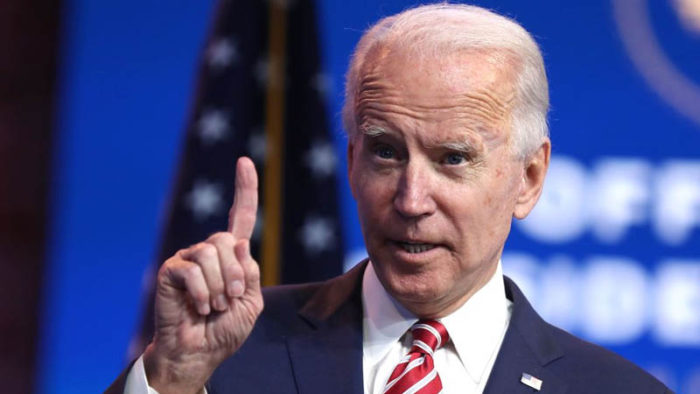“I hope everybody realizes by now, these masks make a difference. We are on the cusp of being able to fundamentally change the nature of this disease because of the way in which we’re able to get vaccines in people’s arms,” Biden said while occasionally tugging at his mask.
“The last thing, the last thing we need is Neanderthal thinking that in the meantime everything is fine, take off your mask, forget it,” he said.
It wasn’t the first time Biden used the term to describe Republicans, referring to them in 2013 as “this Neanderthal crowd.”
On Tuesday, Texas Gov. Greg Abbott announced his state will open “100%” next Wednesday, arguing cases and hospitalizations have dropped precipitously, vaccines are being distributed and “too many Texans have been sidelined from employment opportunities” and “too many small business owners have struggled to pay their bills.”
“I am ending the statewide mask mandate. Texans have mastered the habits to keep from getting COVID,” Abbott said.
Later Tuesday, Mississippi Republican Gov. Tate Reeves announced he is replacing all current executive orders regarding coronavirus mitigation with “recommendations.”
Meanwhile, Biden was asked Tuesday by a reporter when the nation will return to “normal.”
“I’ve been cautioned not to give an answer for that because we do not know for sure. But my hope is by this time next year we’ll be back to normal,” he replied. “But again it depends on people to continue, to continue to be smart and understand that we still can have significant losses.”
But that dire assessment may be too optimistic, White House coronavirus adviser Dr. Anthony Fauci said Tuesday.
“I don’t think we’re going to be completely normal a year from now,” Fauci said during an event organized by the University of Edinburgh. “But I hope we’re well on the way to normality so that we can ultimately get the world protected at the same time as we get economic recovery so that all the unintended consequences of shutting down begin to normalize, including other health issues that have arisen because of the shutdown.”
In contrast, Democratic Colorado Gov. Jared Polis said at a news conference Tuesday he believes his state will be “very close to normal” by this summer.
Dr. Marty Makary, a professor at the Johns Hopkins School of Medicine, wrote in a Wall Street Journal op-ed Feb. 18 that with cases down 77% over the previous six weeks, herd immunity is developing, and he expects COVID-19 “will be mostly gone by April, allowing Americans to resume normal life.”
NEW: President Biden calls Texas and Mississippi decisions to end mask mandates “a big mistake” and criticizes what he views as “Neanderthal thinking” after CDC warned against complacency in the face of emerging coronavirus variants on Monday. pic.twitter.com/Mmdln3gNG6
— NBC News (@NBCNews) March 3, 2021
At the White House on Wednesday, press secretary Jen Psaki took a shot a President Trump, whose Operation Warp Speed produced a vaccine in record time, five times faster than any other in history.
“This entire country has paid the price for political leaders who ignored the science when it comes to the pandemic,” she said at the daily press briefing. “There’s still more work to be done. We need to remain vigilant.”
On his first day in office, Biden signed an executive order requiring for 100 days the wearing of masks on federal property.
California Gov. Gavin Newsom on Tuesday called Abbott’s move “absolutely reckless,” and a Texas Democratic lawmaker urged him to reconsider.
“Texas will experience more cases, more hospitalizations and more deaths,” said state Rep. Richard Peña Raymond, who is from the border city of Laredo.
‘No clear, significant beneficial effect’
However, a peer-reviewed study published in the European Journal of Clinical Investigation on Jan. 5 comparing cases in 10 countries, including the U.S., found there was “no clear, significant beneficial effect of [more restrictive measures] on case growth in any country.”
“We do not question the role of all public health interventions, or of coordinated communications about the epidemic, but we fail to find an additional benefit of stay-at-home orders and business closures,” the researchers said.
WND reported in February the 11 U.S. states that did not impose comprehensive lockdowns over the fall and winter in response to the coronavirus fared better than states that did, according to an analysis of public data.
The U.K.-based website Lockdown Sceptics noted that the models one year ago predicting that nations, regions and states that didn’t impose lockdowns would face overrun hospitals and massive death tolls compared to those that did lock down turned out to be wrong.
It was a model published by Neil Ferguson of Imperial College of London forecasting 2.2 million American deaths from COVID-19 that prompted President Trump to initiate the “15 days to slow the spread.” White House coronavirus advisers Anthony Fauci and Deborah Birx presented the study to Trump, urging drastic action.
In November, as WND reported, the first large, randomized controlled trial of its kind showed no statistically significant difference in COVID-19 cases between people who wore masks and those who did not.
In October, an analysis of a dozen graphs charting the number of COVID-19 cases in countries and U.S. states confirmed the conclusions of recent studies that mask mandates had no effect on the spread of the disease.
At the time, Sweden’s chief epidemiologist, Anders Tegnell, relied heavily on the public adopting a strategy of herd immunity to allow them to build up antibodies. Although admitting that the use of masks could be considered when visiting busy and confined places, he has been against mass mask mandates.
“The evidence is weak,” he told Science magazine. “Countries that have masks are not doing the best right now. It is very dangerous to try to believe that masks are a silver bullet.”
Swedish authorities actively discouraged people from wearing face masks which, they said, would spread panic, are often worn the wrong way and can provide a false sense of safety.
That was Anthony Fauci’s argument in a “60 Minutes” interview in March 2020 when he said that, in general, “people should not be walking around with masks.”
“Right now in the United States, people should not be walking around with masks.
“You’re sure of it? Because people are listening really closely to this,” he was asked.
“There’s no reason to be walking around with a mask. When you’re in the middle of an outbreak, wearing a mask might make people feel a little bit better and it might even block a droplet, but it’s not providing the perfect protection that people think that it is. And, often, there are unintended consequences — people keep fiddling with the mask and they keep touching their face.”
A study by the Centers for Disease Control in October indicated that Americans were adhering to mask mandates, but they didn’t appear to have slowed or stopped the spread of the coronavirus. And further, it found, mask-wearing has negative effects.
A change in ‘the consensus’
The Association of American Physicians and Surgeons has compiled a page of “Mask Facts” that explains the basic science behind mask-wearing and summarizes a variety of studies.
It shows that the consensus prior to the coronavirus pandemic was that the effectiveness of mask-wearing by the general public in slowing the spread of a virus is unproven, and there’s evidence it does more harm than good.
On April 6, 2020, the World Health Organization said the “wide use of masks by healthy people in the community setting is not supported by current evidence and carries uncertainties and critical risks.” Just two months, later, however, as the pandemic surged, the WHO changed its stance without providing any evidence with randomized controlled trials.
On March 5, the Centers for Disease Control said masks “are usually not recommended in “non-health care settings.”
But on Aug. 7, the CDC said it “recommends that people wear masks in public settings and when around people who don’t live in your household, especially when other social distancing measures are difficult to maintain.”
Harm 10 times worse than benefits
In January 2021, WND reported a Canadian infectious-disease specialist who initially supported the lockdowns changed his mind, concluding in his peer-reviewed study that the harm is 10 times worse than the benefits.
One year ago, a top coronavirus adviser for Joe Biden was in agreement.
Michael T. Osterholm, a professor and director of the Center for Infectious Disease Research and Policy at the University of Minnesota, formerly advocated the “focused protection” strategy now promoted by epidemiologists at Stanford and Oxford advising Florida Gov. Ron DeSantis: With a 99% survival rate for most, according to the Centers for Disease Control, let the healthy go about their business while protecting the vulnerable, the people over 70 with multiple life-threatening diseases.
Osterholm warned in a March 21, 2020, op-ed for the Washington Post of the high economic and social costs of “the near-draconian lockdowns” in effect at the time in China and Italy, which ultimately don’t reduce the number of cases. In November 2020, however, he advocated a national lockdown of four to six weeks.
The CDC estimates a 99.997% survival rate for those from birth to age 19 who contract COVID-19. It’s 99.98% for ages 20-49, 99.5% for 50-69 and 94.6% for those over 70. Significantly, those who died of coronavirus, according to the CDC, had an average of 2.6 comorbidities, meaning more than two chronic diseases along with COVID-19. Overall, the CDC says, just 6% of the people counted as COVID-19 deaths died of COVID-19 alone.







